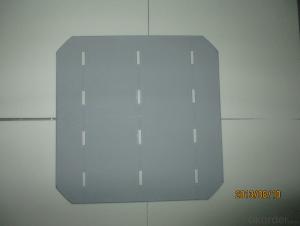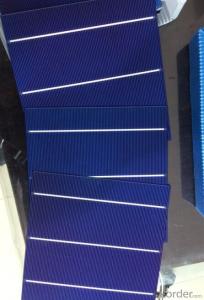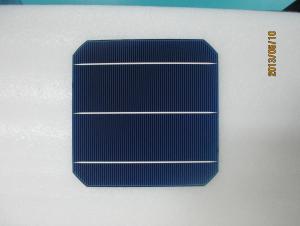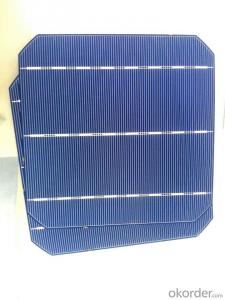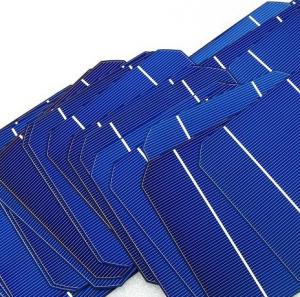High Efficiency 156*156mm Monocrystal Solar Cell for Solar Energy Materials and Solar Cells
- Loading Port:
- Shanghai
- Payment Terms:
- TT or LC
- Min Order Qty:
- 1000 pc
- Supply Capability:
- 20000000 pc/month
OKorder Service Pledge
OKorder Financial Service
You Might Also Like
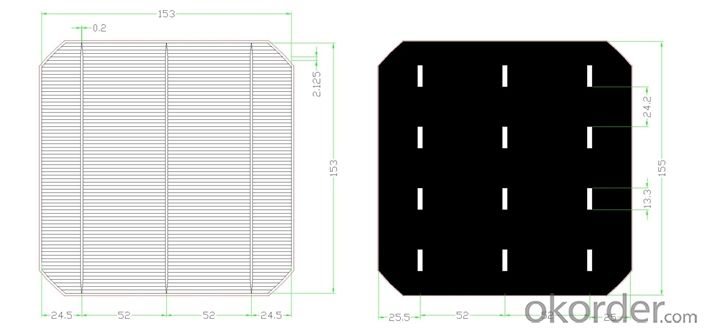
Monocrystal solar energy cell
Type:156M
Appearance:156×1565㎜±0.5mm; Diagonal:R=100mm
Main fence wide:1.4-1.5mm Back electrode wide:2-2.5mm
Fence line qty:90
Cell thickness:220um±20um
Eff(%) | 18.50- 18.60 | |||||||||||
Pm(W) | 4.48 | |||||||||||
Isc(A) | 8.84 | |||||||||||
Im(A) | 8.36 | |||||||||||
Voc(V) | 0.634 | |||||||||||
Vm(V) | 0.536 | |||||||||||
FF(%) | 79.3 |

remark:our company cells as per working current concentrate principle,separate the first and the second grade
Usage of Polycrystalline Solar Cells
Solar cells are often electrically connected and encapsulated as a module. Photovoltaic modules often have a sheet of glass on the front (sun up) side, allowing light to pass while protecting the semiconductor wafers from abrasion and impact due to wind-driven debris, rain, hail, etc. Solar cells are also usually connected in series in modules, creating an additive voltage. Connecting cells in parallel will yield a higher current; our solar cells have passed IEC Certification. With high and stable quality, our cells can greatly improve the performance of Solar Modules.
Factory Picture of Solar Cells

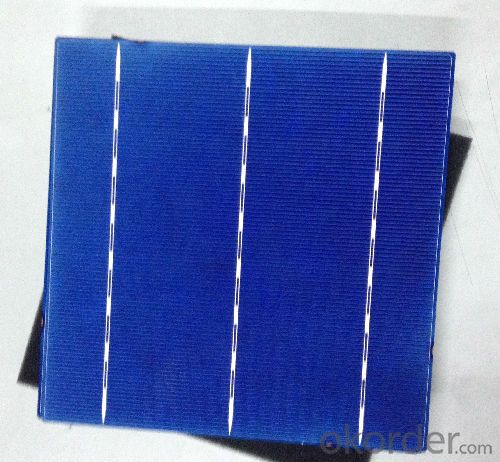
FAQ
We have organized several common questions for our clients,may help you sincerely:
What’s price per watt?
A: It’s depends on the quantity, delivery date and payment terms of the order. We can talk further about the detail price issue. Our products is high quality with lower price level.
Can you tell me the parameter of your solar cells?
We have different series of cells with different power output, both from c-si to a-si. Please take our specification sheet for your reference.
How do you pack your products?
We have rich experience on how to pack the panels to make sure the safety on shipment when it arrives at the destination.
Can you do OEM for us?
Yes, we can.
How long can we receive the product after purchase?
In the purchase of product within three working days, We will arrange the factory delivery as soon as possible. The perfect time of receiving is related to the state and position of customers. Commonly 7 to 10 working days can be served
- Q: Can solar cells be used in hybrid systems?
- Yes, solar cells can be used in hybrid systems. Hybrid systems combine different sources of energy, such as solar, wind, or fossil fuels, to generate electricity. Solar cells can be integrated into these systems to harness solar energy and contribute to the overall power generation. This allows for a more sustainable and efficient energy production, reducing reliance on traditional energy sources.
- Q: Can solar cells be used in transportation?
- Yes, solar cells can be used in transportation. Solar-powered vehicles, such as solar cars and solar-powered boats, harness energy from the sun through photovoltaic cells to generate electricity and propel the vehicle. Additionally, solar cells can be used to power auxiliary systems in transportation, such as charging electric vehicles or providing energy for lighting and ventilation in public transportation systems. The use of solar cells in transportation helps reduce reliance on fossil fuels and contributes to a more sustainable and environmentally friendly mode of transportation.
- Q: Can solar cells be used in remote sensing devices?
- Yes, solar cells can be used in remote sensing devices. Solar cells are capable of converting sunlight into electricity, making them an ideal power source for remote sensing devices that require continuous operation in areas where traditional power sources are unavailable or impractical to use.
- Q: How do solar cells perform in areas with limited sunlight?
- Solar cells do not perform as efficiently in areas with limited sunlight, as their energy production is directly dependent on the amount of sunlight available. However, advancements in solar cell technology have improved their ability to generate electricity even in low light conditions.
- Q: How do solar cells perform in high altitude locations?
- Solar cells tend to perform better in high altitude locations due to the thinner atmosphere. With less air to scatter and absorb sunlight, solar cells can capture more solar radiation, resulting in increased energy production. Additionally, the lower temperatures at higher altitudes can also enhance the efficiency of solar cells.
- Q: What is the typical lifespan of a solar cell?
- The typical lifespan of a solar cell is around 25 to 30 years.
- Q: Is the Solar Power Photovoltaic Cells the same as PV cells modules?
- According to the application needs, solar cells after a certain combination, to achieve a certain rated output power and output voltage of a group of photovoltaic cells, called PV modules
- Q: How can I understand the working principles of solar cells?
- My way of understand the working principles of solar cells is to read tons of books about that topic.
- Q: Can solar cells be used in weather monitoring systems?
- Yes, solar cells can be used in weather monitoring systems. Solar cells are used to convert sunlight into electrical energy, which can power various components of weather monitoring systems such as sensors, data loggers, and communication devices. This allows for autonomous and sustainable operation of weather monitoring systems in remote locations where access to traditional power sources may be limited.
- Q: How does a solar cell raise industrial efficiency?
- A solar cell provides long-lasting electricity which is vital in factories, that's how it raises efficiency.
Send your message to us
High Efficiency 156*156mm Monocrystal Solar Cell for Solar Energy Materials and Solar Cells
- Loading Port:
- Shanghai
- Payment Terms:
- TT or LC
- Min Order Qty:
- 1000 pc
- Supply Capability:
- 20000000 pc/month
OKorder Service Pledge
OKorder Financial Service
Similar products
Hot products
Hot Searches
Related keywords
